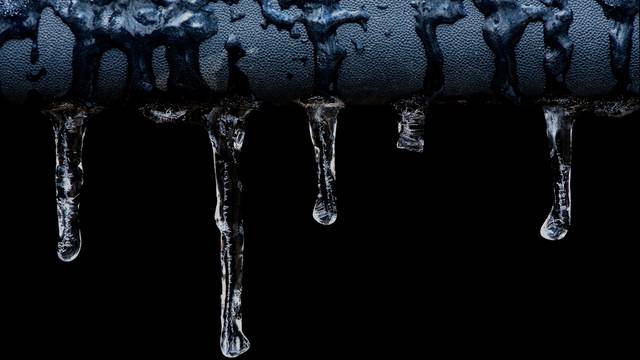During winter, pipes can freeze and cause water damage, leading to expensive repairs. Protecting your plumbing from freezing temperatures is crucial. Here are five essential tips to prevent frozen pipes during the winter months:
Insulate Pipes:
Insulation is critical to protecting pipes from freezing. Insulate exposed and vulnerable pipes, especially those in unheated areas like basements, crawl spaces, or attics. Wrap foam pipe insulation sleeves or heat tape around pipes for additional cold protection.
Maintain Adequate Heating:
Keeping your home warm enough is essential, especially in areas with pipes. To prevent pipes from freezing, maintain a consistent indoor temperature of at least 55°F, even when you’re away. Proper heating can help prevent pipes from reaching freezing temperatures.
Allow Faucets to Drip:
Allow faucets connected to pipes more susceptible to freezing, such as those in unheated spaces or exterior walls, to drip slightly during cold weather. By allowing a small amount of water to flow through the pipes, you can help prevent them from becoming frozen and potentially causing damage to your home.
Seal Cracks and Openings:
Inspect your home for gaps or openings that allow cold air to enter and affect the pipes’ temperature. Seal gaps around windows, doors, and foundation walls using caulk or weather-stripping. Proper insulation and sealing help maintain warmer temperatures around pipes.
Drain and Shut Off Outdoor Faucets:
Before freezing temperatures arrive:
- Shut off and drain outdoor water faucets and irrigation systems.
- Disconnect and store garden hoses.
- Ensure that any outdoor pipes or faucets are adequately drained to prevent water from freezing inside them.
Additional Tips to Consider:
- Consider leaving the cabinet doors beneath the sinks open. This helps warm air circulate the pipes, keeping them cozy during the colder weather.
- If you plan to be away during cold weather, keep the thermostat set to a consistent temperature and consider asking someone to check on your home to ensure adequate heating.
- Consider installing a smart thermostat or a temperature monitoring system that alerts you to drops in indoor temperatures, indicating potential freezing risks.

At What Temperature Can Pipes Freeze?
Pipes can freeze when temperatures drop below the freezing point of 32 degrees Fahrenheit. However, the precise temperature at which pipes freeze can vary depending on several factors:
Duration of Cold Weather
Prolonged exposure to temperatures below freezing increases the risk of pipes freezing. Extended periods of cold weather can gradually reduce the temperature of pipes, leading to freezing.
Type of Pipes
Different types of pipes have varying resistance to freezing. Metal pipes, especially those without proper insulation, freeze more quickly than plastic or PVC pipes. Exposed pipes are at higher risk compared to those located within insulated walls.
Pipe Location
Pipes in crawl spaces, attics, or exterior walls that are not heated or properly insulated are more prone to freezing. Additionally, pipes outdoors or in areas with minimal heating are prone to freezing at higher temperatures.
Water Flow
When water flows continuously through pipes, it can be less prone to freezing. Slow-moving or stagnant water within pipes increases the likelihood of freezing, as the water movement generates less heat.
Wind Chill Factor
Wind can accelerate the rate at which pipes freeze. Even if the air temperature is above freezing, strong winds can rapidly decrease the temperature around exposed pipes, leading to freezing.
Generally, when temperatures remain consistently at or below 32°F for several hours or longer, pipes are more likely to freeze. It’s essential to take preventive measures, such as insulation, maintaining indoor temperatures, and allowing faucets to drip during cold weather to minimize the risk of frozen pipes and potential water damage.

What Should I Do if My Pipes Freeze?
If, despite preventive measures, you suspect that pipes are frozen:
- Keep affected faucets open to allow water to flow once the pipes thaw.
- To detect a frozen pipe, look for visible signs like condensation or cracks, or run your hands along the pipes to find colder sections. You can compare the temperature with a pipe where water flows freely. Multiple frozen areas can occur in a single water pipe, especially near exterior walls.
- Apply gentle heat to the frozen section using a hair dryer, heating pad, or warm towels. Avoid the use of high-temperature devices or open flames.
- Contact a licensed plumber immediately if you cannot locate the frozen area. If the pipe has already burst, don’t wait until it is too late, contact a water damage restoration company such as United Water Restoration Group and begin extraction and drying immediately. Extracting the standing water caused by the burst pipe will reduce the possibility of bacterial growth and extensive damage to your home’s structure and personal contents.
Following these preventive measures can significantly reduce the risk of frozen pipes and potential water damage during the winter months. Prioritize proactive steps to protect your plumbing system, ensuring a warm and hassle-free winter season.
Contact United Water Restoration Group For Freezing Pipes
United Water Restoration Group offers swift and expert assistance when dealing with frozen pipes or water damage caused by burst pipes. Our team of professionals is always ready to respond promptly to emergencies, providing comprehensive restoration services. Specializing in drying and property restoration, United Water Restoration Group ensures a rapid recovery process, guiding property owners through restoration and returning the property to its pre-damage state. Call Us Today!





